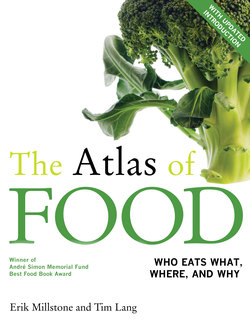Читать книгу The Atlas of Food - Erik Millstone - Страница 9
На сайте Литреса книга снята с продажи.
ОглавлениеPower in the food chain One of the particular weaknesses in the analysis “the world must produce more food” is that it downplays or ignores the shifts of power in the food system, away from farmers and consumers in favour of traders, retailers and speculators. In 2012, UNCTAD produced a report showing that financiers traded food contracts as if there was 30 times more food on the planet than there was. They are applying fantasy economics to food, much as they did to mortgages, borrowings and savings. Food traders and retailers increasingly control supply chains from farmers to consumers, making decisions not just about quantities and prices but also quality. Despite the rhetoric of the food retailers and processors that the system is driven by individual consumer choices, large agri-business corporations make the key decisions that impact on both farmers and consumers. Corporations often claim they are just responding to the demands of consumers; otherwise (they argue) they would be out of business. But while consumers are portrayed as the arbiters of choice and taste, as individuals we often recognize the limits to our power to influence them. Why would we, the world’s consumers, choose to starve or to be obese, or suffer from diet-related diseases? Most consumers would prefer a food system that caused less harm to our environment. Poor hungry people have even fewer options than affluent consumers, while affluent consumers can only choose from what the food industry has deemed it sufficiently profitable to provide. Farmers are also increasingly dependent on large corporations for seeds, fertilizers, pesticides, machinery and fuel. “Local” decisions are influenced by global markets, on the commodity and futures trading floors, in banks, boardrooms, factories and laboratories. An unsustainable system The systematic picture this atlas offers is not meant to imply that the world of food is ordered in some kind of machine-like fashion. On the contrary, it is in fluid and volatile state. Some of its features help explain its instability; they cannot survive unchanged in the long-term, or even the medium-term, for ecological, economic, social or political reasons. A world that only produced and ate food as people in the USA or Europe do is unsustainable by any definition. It would use more land and energy than is available on Earth. Scientists and technologists have been studying crops, livestock, farming systems, food processing and distribution since the 18th century. Compared to all human history, let alone planetary evolution, the rates of technological change in farming and the food systems have been particularly rapid and recent. The changes in the patterns of investment in research, development and innovation have had substantial economic, social and environmental consequences. There is now widespread agreement that natural resources such as land, water and energy are under increasing stress as a consequence of the operation of the food system. Forest clearance has diminished the extent to which natural vegetation has been available to absorb increasing emissions of carbon dioxide, and the cattle farmed on cleared forest land are notorious producers of methane, which is 21 times more potent as a greenhouse gas than carbon dioxide. Through such interactions, the technological, industrial, economic, environmental, social and political aspects of the food system influence each other. Those dynamic interactions are undermining the sustainability of the food system; they cannot remain unchanged. High-technology industrial food systems are spreading across the world, raising critical policy questions of strategy, direction, acceptability and sustainability.
10
